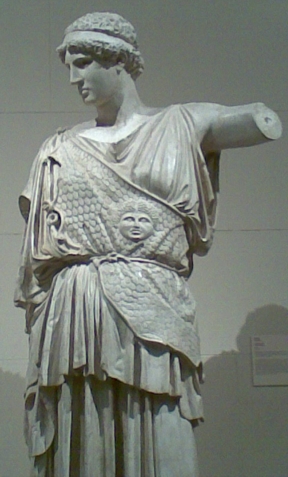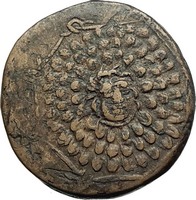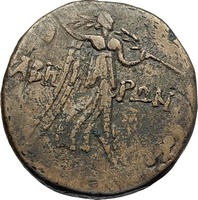Greek city of Kabeira in Pontus
Bronze 21mm (6.74 grams) Struck under Mithradates VI the Great circa 105-90 B.C. or circa 95-90 B.C.
Reference: HGC 7, 272 (scarce); Sear 3653; SNG Black Sea 1243-1246
Aegis, with Gorgon's head at center.
Nike advancing right carrying wreath and palm branch; KABH - PΩN across fields. Situated in the valley of the Lykos, Kabeira was a favorite residence of Mithradates, and it was in the vicinity of this place that the Pontic King was defeated by Lucullus in 71 B.C. You are bidding on the exact item pictured, provided with a Certificate of Authenticity and Lifetime Guarantee of Authenticity.
In Ancient Greece, the Gorgoneion (Greek: Γοργόνειον) was originally a horror-creating apotropaic pendant showing the Gorgon's head. It was assimilated by the Olympian deities Zeus and Athena: both are said to have worn it as a protective pendant. It was assumed, among other godlike attributes, as a royal aegis, by rulers of the Hellenistic age, as shown, for instance, on the Alexander Mosaic and the Gonzaga Cameo.  Homer refers to the Gorgon on four occasions, each time alluding to the head alone, as if the creature had no body. Jane Ellen Harrison notes that "Medusa is a head and nothing more...a mask with a body later appended". Up to the 5th century BC, the head was depicted as particularly ugly, with a protruding tongue, boar tusks, puffy cheeks, her eyeballs staring fixedly on the viewer and the snakes twisting all around her. Homer refers to the Gorgon on four occasions, each time alluding to the head alone, as if the creature had no body. Jane Ellen Harrison notes that "Medusa is a head and nothing more...a mask with a body later appended". Up to the 5th century BC, the head was depicted as particularly ugly, with a protruding tongue, boar tusks, puffy cheeks, her eyeballs staring fixedly on the viewer and the snakes twisting all around her.
The direct frontal stare, "seemingly looking out from its own iconographical context and directly challenging the viewer", was highly unusual in ancient Greek art. In some instances a beard (probably standing for streaks of blood) was appended to her chin, making her appear as an orgiastic deity akin to Dionysus. Gorgoneia that decorate the shields of warriors on mid-5th century Greek vases are considerably less grotesque and menacing. By that time, the Gorgon had lost her tusks and the snakes were rather stylized. The Hellenistic marble known as the Medusa Rondanini illustrates the Gorgon's eventual transformation into a beautiful woman.
 The aegis or aigis, as stated in the Iliad, is carried by Athena and Zeus, but its nature is uncertain. It had been interpreted as an animal skin or a shield, sometimes bearing the head of a Gorgon. There may be a connection with a deity named Aex or Aix, a daughter of Helios and a nurse of Zeus or alternatively a mistress of Zeus (Pseudo-Hyginus, Astronomica 2. 13). The aegis of Athena is referred to in several places in the Iliad. It produced a sound as from a myriad roaring dragons (Iliad, 4.17) and was borne by Athena in battle "... and among them went bright-eyed Athene, holding the precious aegis which is ageless and immortal: a hundred tassels of pure gold hang fluttering from it, tight-woven each of them, and each the worth of a hundred oxen." The aegis or aigis, as stated in the Iliad, is carried by Athena and Zeus, but its nature is uncertain. It had been interpreted as an animal skin or a shield, sometimes bearing the head of a Gorgon. There may be a connection with a deity named Aex or Aix, a daughter of Helios and a nurse of Zeus or alternatively a mistress of Zeus (Pseudo-Hyginus, Astronomica 2. 13). The aegis of Athena is referred to in several places in the Iliad. It produced a sound as from a myriad roaring dragons (Iliad, 4.17) and was borne by Athena in battle "... and among them went bright-eyed Athene, holding the precious aegis which is ageless and immortal: a hundred tassels of pure gold hang fluttering from it, tight-woven each of them, and each the worth of a hundred oxen."
Medusa, the gorgon, was beheaded by the hero Perseus, who thereafter used her head, which retained its ability to turn onlookers to stone, as a weapon until he gave it to the goddess Athena to place on her shield. In classical antiquity the image of the head of Medusa appeared in the evil-averting device known as the Gorgoneion. Gorgons were a popular image in Greek mythology, appearing in the earliest of written records of Ancient Greek religious beliefs such as those of Homer, which may date to as early as 1194-1184 BC. Because of their legendary and powerful gaze that could turn one to stone, images of the Gorgons were put upon objects and buildings for protection. The modern concept of doing something "under someone's aegis" means doing something under the protection of a powerful, knowledgeable, or benevolent source. The word aegis is identified with protection by a strong force with its roots in Greek mythology and adopted by the Romans; there are parallels in Norse mythology and in Egyptian mythology as well, where the Greek word aegis is applied by extension.
 In Greek mythology, Nike was a goddess who personified victory, also known as the Winged Goddess of Victory. The Roman equivalent was Victoria. Depending upon the time of various myths, she was described as the daughter of Pallas (Titan) and Styx (Water) and the sister of Kratos (Strength), Bia (Force), and Zelus (Zeal). Nike and her siblings were close companions of Zeus, the dominant deity of the Greek pantheon. According to classical (later) myth, Styx brought them to Zeus when the god was assembling allies for the Titan War against the older deities. Nike assumed the role of the divine charioteer, a role in which she often is portrayed in Classical Greek art. Nike flew around battlefields rewarding the victors with glory and fame. In Greek mythology, Nike was a goddess who personified victory, also known as the Winged Goddess of Victory. The Roman equivalent was Victoria. Depending upon the time of various myths, she was described as the daughter of Pallas (Titan) and Styx (Water) and the sister of Kratos (Strength), Bia (Force), and Zelus (Zeal). Nike and her siblings were close companions of Zeus, the dominant deity of the Greek pantheon. According to classical (later) myth, Styx brought them to Zeus when the god was assembling allies for the Titan War against the older deities. Nike assumed the role of the divine charioteer, a role in which she often is portrayed in Classical Greek art. Nike flew around battlefields rewarding the victors with glory and fame.
Nike is seen with wings in most statues and paintings. Most other winged deities in the Greek pantheon had shed their wings by Classical times. Nike is the goddess of strength, speed, and victory. Nike was a very close acquaintance of Athena, and is thought to have stood in Athena's outstretched hand in the statue of Athena located in the Parthenon. Nike is one of the most commonly portrayed figures on Greek coins. Names stemming from Nike include amongst others: Nicholas, Nicola, Nick, Nikolai, Nils, Klaas, Nicole, Ike, Niki, Nikita, Nika, Niketas, and Nico.
 Mithridates VI or Mithradates VI (Greek: Μιθραδάτης), from Old Persian Mithradatha, "gift of Mithra"; 134-63 BC, also known as Mithradates the Great (Megas) and Eupator Dionysius, was king of Pontus and Armenia Minor in northern Anatolia (now Turkey) from about 120-63 BC. Mithridates is remembered as one of the Roman Republic's most formidable and successful enemies, who engaged three of the prominent generals from the late Roman Republic in the Mithridatic Wars: Lucius Cornelius Sulla, Lucullus and Pompey. He was also the greatest ruler of the Kingdom of Pontus.
Cabira, a place in Pontus, at the base of the range of Paryadres, about 150 stadia south of Eupatoria or Magnopolis, which was at the junction of the Iris and the Lycus. Eupatoria was in the midst of the plain, but Cabira, as Strabo says (p. 556), was at the base of the Paryadres. Mithridates the Great built a palace at Cabira; and there was a water-mill there (Greek: ὑδραλέτης), and places for keeping wild animals, hunting grounds, and mines. Less than 200 stadia from Cabira was the remarkable rock or fortress called Caenon (Greek: Καινόν), where Mithridates kept his most valuable things. Cn. Pompeius took the place and its treasures, which, when Strabo wrote, were in the Roman Capitol. In Strabo's time a woman, Pythodoris, the widow of King Polemo, had Cabira with the Zelitis and Magnopolitis. Pompeius made Cabira a city, and gave it the name Diopolis. Pythodoris enlarged it, and gave it the name Sebaste, which is equivalent to Augusta; and she used it as her royal residence. Near Cabira probably (for the text of Strabo is a little uncertain, and not quite clear; Groskurd, transl. vol. ii. p. 491, note) at a village named Ameria, there was a temple with a great number of slaves belonging to it, and the high priest enjoyed this benefice. The god Men Pharnaces was worshipped at Cabira. Mithridates was at Cabira during the winter that L. Lucullus was besieging Amisus and Eupatoria. (Appian, Mithrid. c. 78.) Lucullus afterwards took Cabira. (Plutarch, Lucullus, c. 18.) There are some autonomous coins of Cabira with the epigraph "Καβηρων". Strabo, a native of Amasia, could not be unacquainted with the site of Cabira. The only place that corresponds to his description is Niksar, on the right bank of the Lycus, nearly 43 km from the junction of the Iris and the Lycus. But Niksar is the representative of Neocaesarea, a name which first occurs in Pliny (vi. 3), who says that it is on the Lycus. There is no trace of any ancient city between Niksar and the junction of the two rivers, and the conclusion that Niksar is a later name of Cabira, and a name more recent than Sebaste, seems certain. (Hamilton's Researches, &c. vol. i. p. 346.) Pliny, indeed, mentions both Sebastia and Sebastopolis in Colopena, a district of Cappadocia, but nothing certain can be inferred from this. Neocaesarea seems to have arisen under the early Roman emperors. Cramer (Asia Minor, vol. i. p. 315) states that the earliest coins of Neocaesarea bear the effigy of Tiberius; but Sestini, quoted by Forbiger (Geog. vol. ii. p. 428), assigns the origin of Neocaesarea to the time of Nero, about 64 CE, when Pontus Polemoniacus was made a Roman province. The simplest solution of this question is that Neocaesarea was a new town, which might be near the site of Cabira. It was the capital of Pontus Polemoniacus, the birthplace of Gregorius Thaumaturgus, and the place of assembly of a church council in 314. Ammianus Marcellinus (xxvii. 12) calls it the most noted city of Pontus Polemoniacus: it was, in fact, the metropolis. According to Paulus Diaconus the place was destroyed by an earthquake. Cramer supposes that Neocaesarea is identical with Ameria, and he adds that Neocaesarea was the principal seat of pagan idolatry and superstitions, which affords another presumption that it had risen on the foundation of Ameria and the worship of Men Pharnaces. But Ameria seems to have been at or near Cabira; and all difficulties are reconciled by supposing that Cabira, Ameria, Neocaesarea [p. 463] were in the valley of the Lycus, and if not on the same spot, at least very near to one another. Stephanus of Byzantium (s. v. Νεοκαισάρεια: Eth. Νεοκαισαριεύς) adds to our difficulties by saying or seeming to say that the inhabitants were also called Adrianopolitae, suggesting the city's name was Adrianopolis or Hadrianopolis. Where he got this from, nobody can tell. Hamilton was informed at Niksar that on the road from Niksar to Sivas, and about fourteen hours from Niksar, there is a high perpendicular rock, almost inaccessible on all sides, with a stream of water flowing from the top, and a river at its base. This is exactly Strabo's description of Caenon.
|


 Homer refers to the Gorgon on four occasions, each time alluding to the head alone, as if the creature had no body. Jane Ellen Harrison notes that "Medusa is a head and nothing more...a mask with a body later appended". Up to the 5th century BC, the head was depicted as particularly ugly, with a protruding tongue, boar tusks, puffy cheeks, her eyeballs staring fixedly on the viewer and the snakes twisting all around her.
Homer refers to the Gorgon on four occasions, each time alluding to the head alone, as if the creature had no body. Jane Ellen Harrison notes that "Medusa is a head and nothing more...a mask with a body later appended". Up to the 5th century BC, the head was depicted as particularly ugly, with a protruding tongue, boar tusks, puffy cheeks, her eyeballs staring fixedly on the viewer and the snakes twisting all around her. The aegis or aigis, as stated in the Iliad, is carried by Athena and Zeus, but its nature is uncertain. It had been interpreted as an animal skin or a shield, sometimes bearing the head of a Gorgon. There may be a connection with a deity named Aex or Aix, a daughter of Helios and a nurse of Zeus or alternatively a mistress of Zeus (Pseudo-Hyginus, Astronomica 2. 13). The aegis of Athena is referred to in several places in the Iliad. It produced a sound as from a myriad roaring dragons (Iliad, 4.17) and was borne by Athena in battle "... and among them went bright-eyed Athene, holding the precious aegis which is ageless and immortal: a hundred tassels of pure gold hang fluttering from it, tight-woven each of them, and each the worth of a hundred oxen."
The aegis or aigis, as stated in the Iliad, is carried by Athena and Zeus, but its nature is uncertain. It had been interpreted as an animal skin or a shield, sometimes bearing the head of a Gorgon. There may be a connection with a deity named Aex or Aix, a daughter of Helios and a nurse of Zeus or alternatively a mistress of Zeus (Pseudo-Hyginus, Astronomica 2. 13). The aegis of Athena is referred to in several places in the Iliad. It produced a sound as from a myriad roaring dragons (Iliad, 4.17) and was borne by Athena in battle "... and among them went bright-eyed Athene, holding the precious aegis which is ageless and immortal: a hundred tassels of pure gold hang fluttering from it, tight-woven each of them, and each the worth of a hundred oxen." In Greek mythology, Nike was a goddess who personified victory, also known as the Winged Goddess of Victory. The Roman equivalent was Victoria. Depending upon the time of various myths, she was described as the daughter of Pallas (Titan) and Styx (Water) and the sister of Kratos (Strength), Bia (Force), and Zelus (Zeal). Nike and her siblings were close companions of Zeus, the dominant deity of the Greek pantheon. According to classical (later) myth, Styx brought them to Zeus when the god was assembling allies for the Titan War against the older deities. Nike assumed the role of the divine charioteer, a role in which she often is portrayed in Classical Greek art. Nike flew around battlefields rewarding the victors with glory and fame.
In Greek mythology, Nike was a goddess who personified victory, also known as the Winged Goddess of Victory. The Roman equivalent was Victoria. Depending upon the time of various myths, she was described as the daughter of Pallas (Titan) and Styx (Water) and the sister of Kratos (Strength), Bia (Force), and Zelus (Zeal). Nike and her siblings were close companions of Zeus, the dominant deity of the Greek pantheon. According to classical (later) myth, Styx brought them to Zeus when the god was assembling allies for the Titan War against the older deities. Nike assumed the role of the divine charioteer, a role in which she often is portrayed in Classical Greek art. Nike flew around battlefields rewarding the victors with glory and fame.

